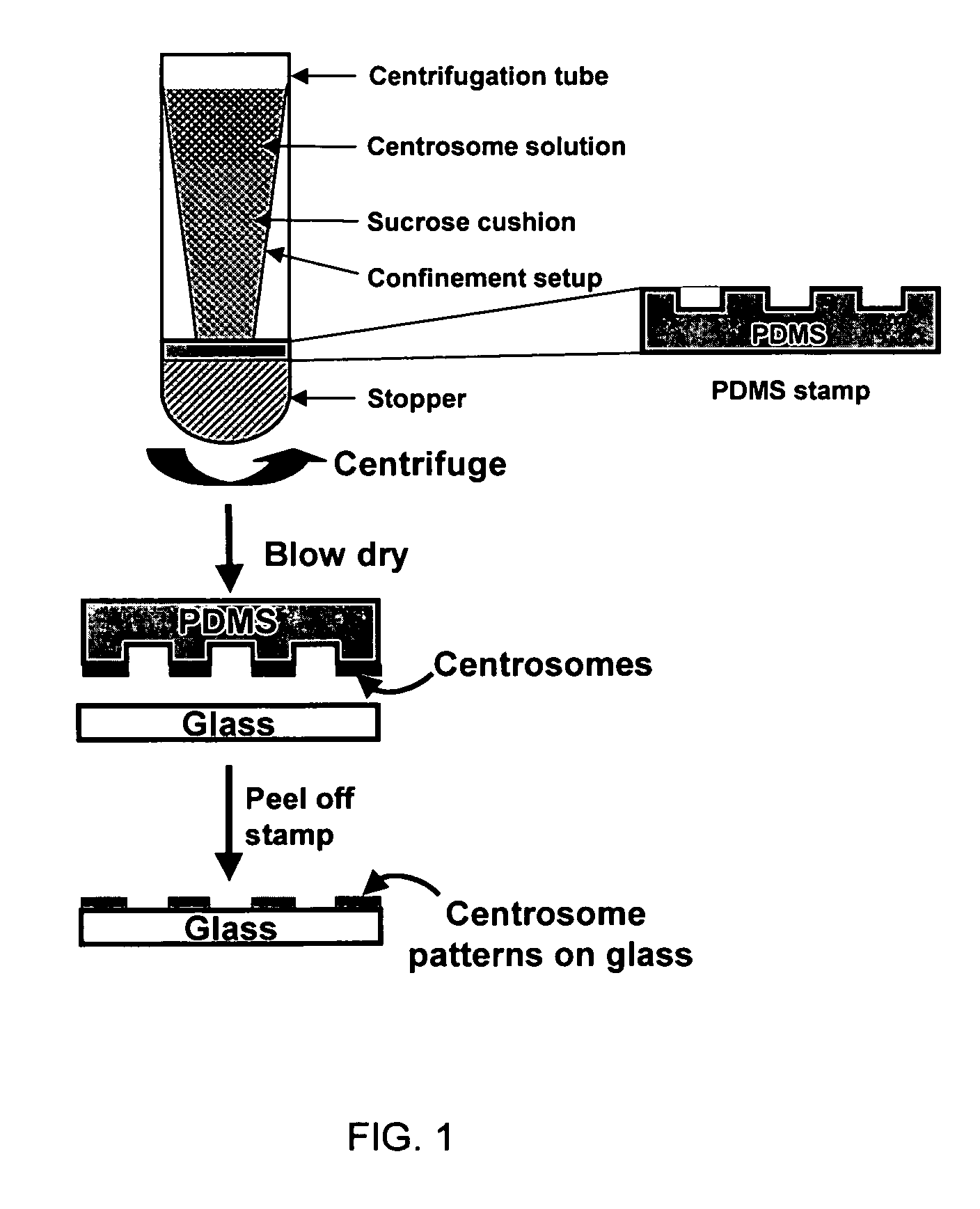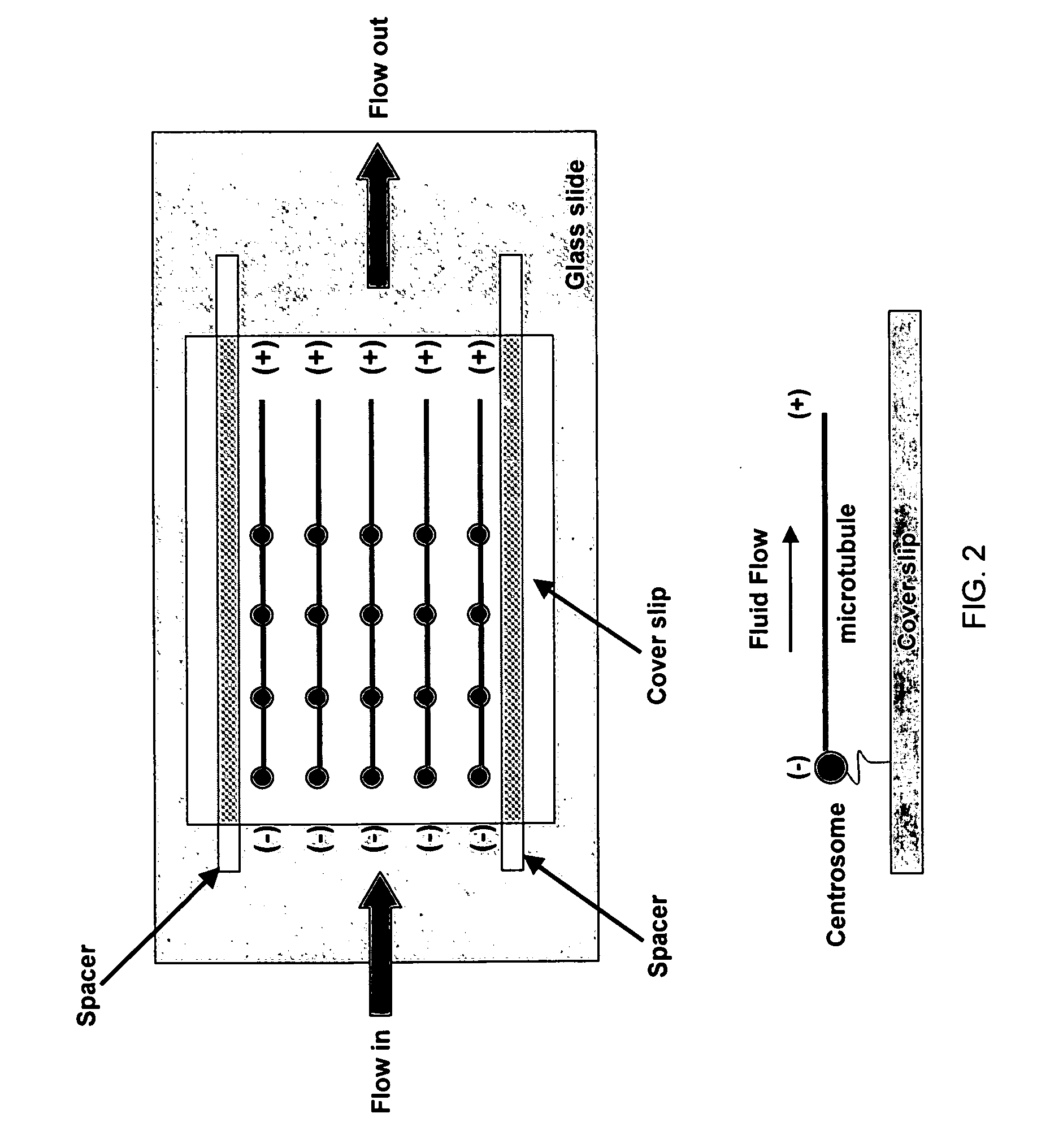Patterning of centrosomes and centrosome fragments as templates for directed growth of microtubules
a technology of centrosomes and templates, applied in the field of centrosomes and centrosome fragments as templates for directed growth of microtubules, can solve the problems of no reports of attempts to apply centrosome-based templates for the control and alignment of microtubules, and achieve the effect of facilitating centrosome deposition and improving the efficiency of the inking step
- Summary
- Abstract
- Description
- Claims
- Application Information
AI Technical Summary
Benefits of technology
Problems solved by technology
Method used
Image
Examples
example 1
Deposition of Centrosomes Using Microcontact Printing (μCp)
[0046] Microcontact printing is a soft lithographic method that has been widely used for protein and cell patterning. Using this method, a clean polydimethysiloxane (PDMS) stamp with micron-scale features (posts or lines) was covered with 10 μL of 107 / mL centrosome solution and inked for 20 h. The stamp was placed in a petri dish with a filter paper moistened by Nanopure water at the bottom to prevent the drying of centrosome solution during the inking process. The stamp was then rinsed with PBS buffer, blow dried, and then brought into contact with a clean cover slip. The PDMS stamp was peeled off from the substrate after about an hour of printing.
[0047] Using this drop-cast method, centrosomes were successfully transferred from the PDMS stamp to the desired area. There were also background patterns of lines or dots that corresponded to original patterns in the PDMS stamp. The contrast in these background patterns appeare...
example 2
Assembly of Centrosomes Using Patterned Substrates
[0049] Substrates having different surface modifications are important in building interfacial devices. To this end, studies of directed assembly of centrosomes using patterned substrates were undertaken. To guide the assembly of centrosomes, patterns of 3-aminopropyltriethoxysilane (APTES) were first fabricated on glass cover slips using micromolding in capillary (MIMIC).
[0050] Micromolding in a capillary is another soft-lithographic method that is used for the patterning of interconnected micro- and nanostructures. During the patterning process, the PDMS stamp is placed on the surface of the substrate and a network of channels form between the stamp and the substrate. When a solution is placed at the open ends of these channels, it spontaneously fills the channels by capillary force, if the solvent in the solution wets the PDMS surface.
[0051] Following this rationale, a clean PDMS stamp with patterns of lines was placed on the s...
example 3
Guided Growth of Microtubules
[0055] Inspired by the capillary flow to pattern APTES onto a substrate, fluid flow alignment of microtubules in microchannels has been accomplished. The strong capillary force inside the PDMS microchannles indeed aligned the microtubules within these channels. To control the orientation of the microtubules in one dimension (1-D), an approach similar to micromolding in the capillary (MIMIC) was applied. Here the MIMIC process is not only being used to spatially position the microtubules, but also using a flow force generated inside the microchannels to guide the growth of microtubules. The PDMS stamp was treated with plasma cleaner for one minute prior to sample preparation in order to change its surface from hydrophobic to hydrophilic. The aqueous solution of tubulin can thus enter the microchannels formed between the PDMS stamp and the glass substrates. To control the growth of microtubules, the tubulin solution (0.7 mg / mL) was first thawed on ice, fo...
PUM
| Property | Measurement | Unit |
|---|---|---|
| contact time | aaaaa | aaaaa |
| width | aaaaa | aaaaa |
| width | aaaaa | aaaaa |
Abstract
Description
Claims
Application Information
 Login to View More
Login to View More - R&D
- Intellectual Property
- Life Sciences
- Materials
- Tech Scout
- Unparalleled Data Quality
- Higher Quality Content
- 60% Fewer Hallucinations
Browse by: Latest US Patents, China's latest patents, Technical Efficacy Thesaurus, Application Domain, Technology Topic, Popular Technical Reports.
© 2025 PatSnap. All rights reserved.Legal|Privacy policy|Modern Slavery Act Transparency Statement|Sitemap|About US| Contact US: help@patsnap.com


